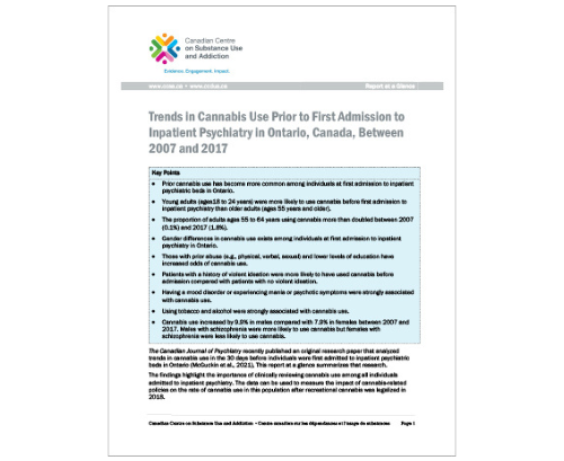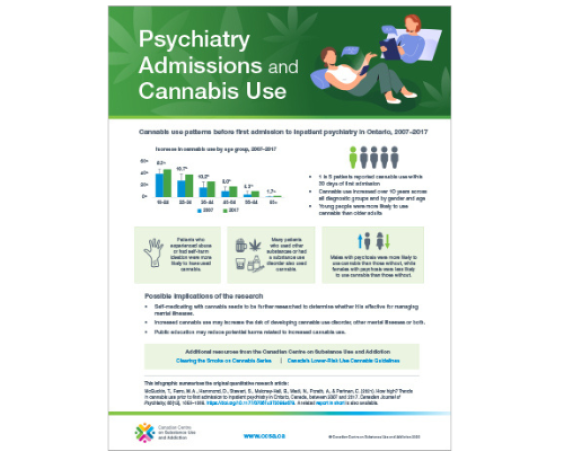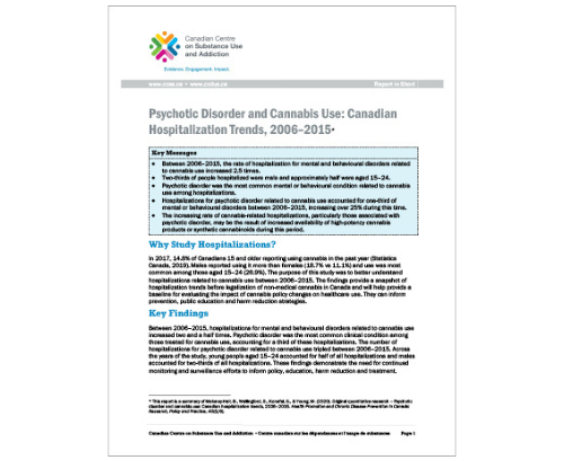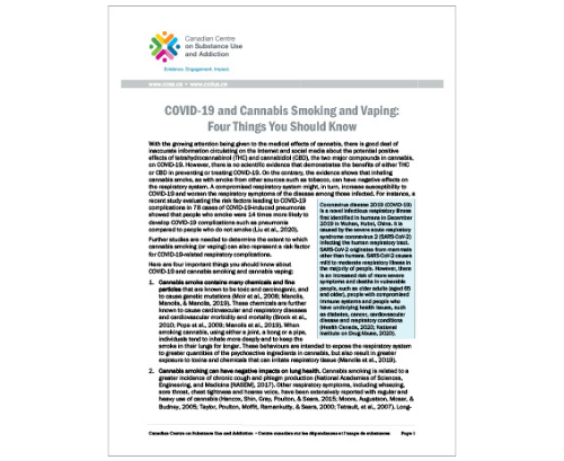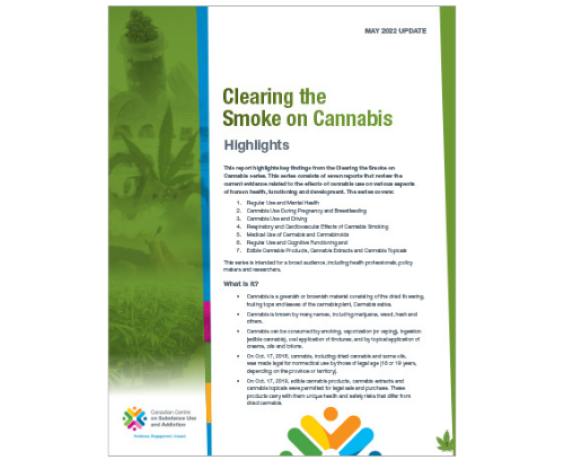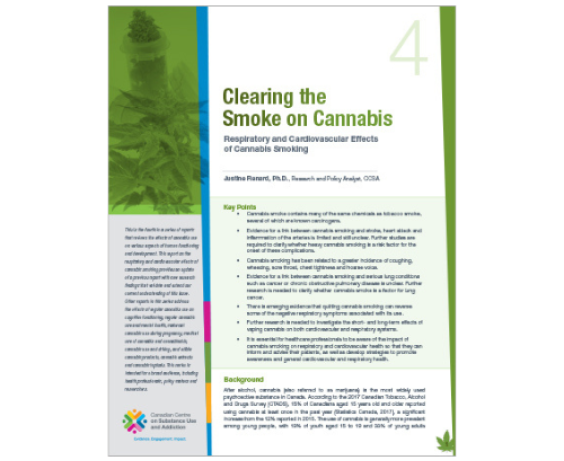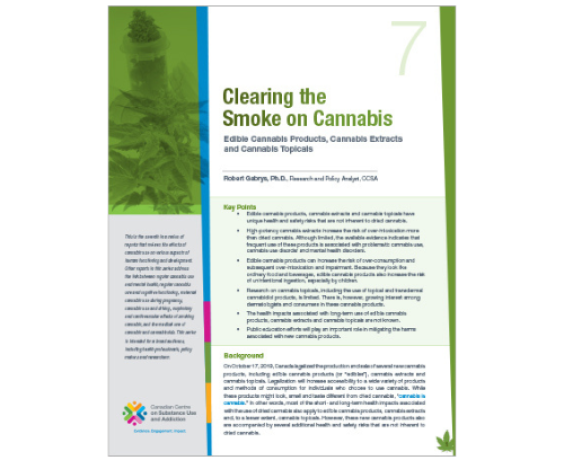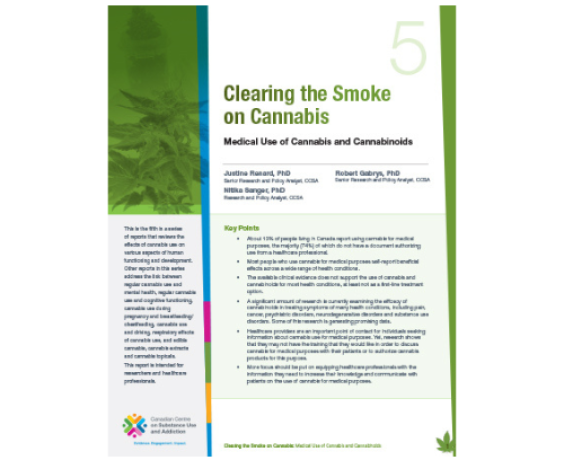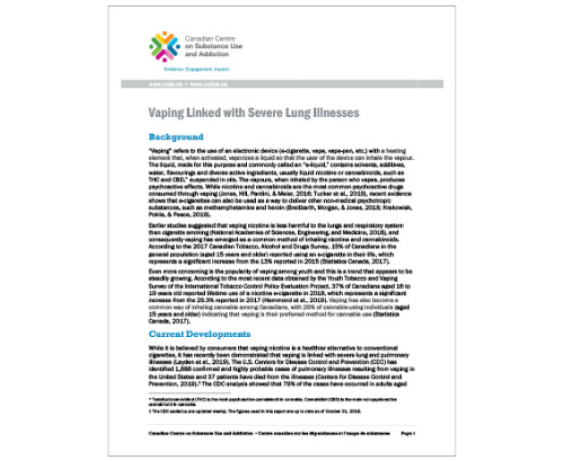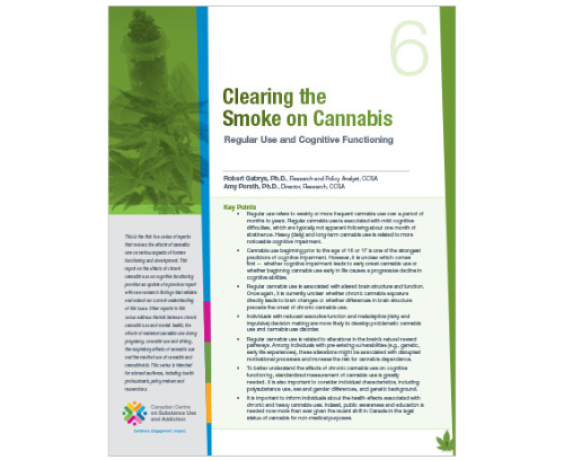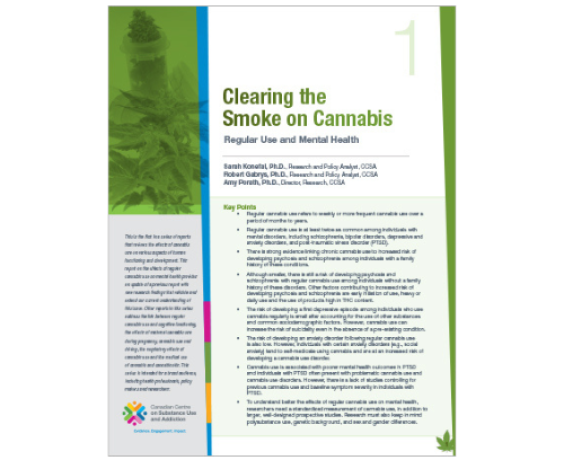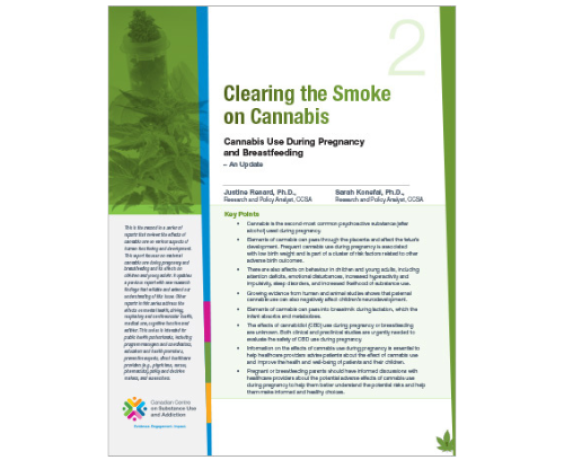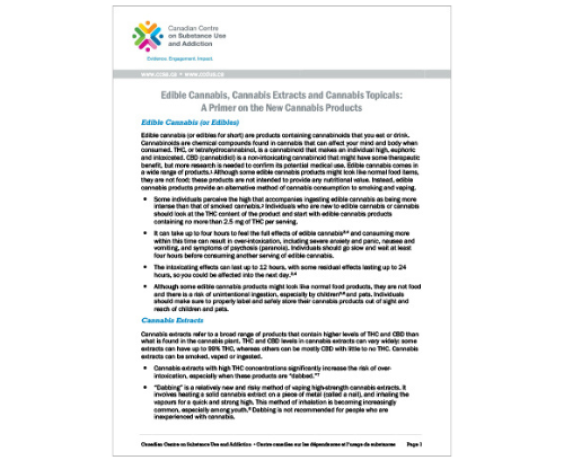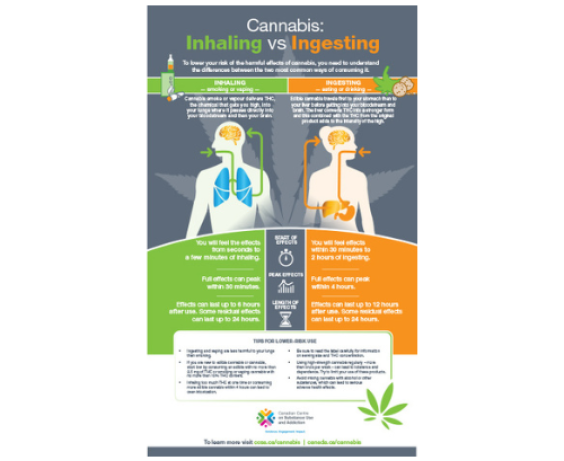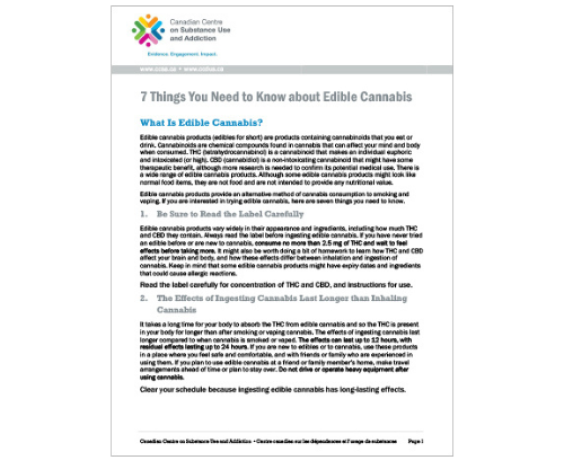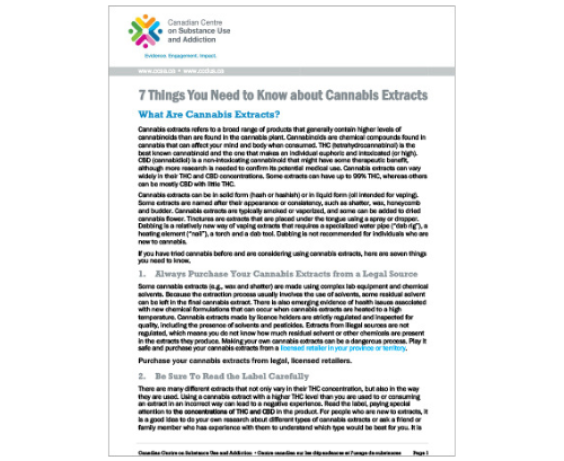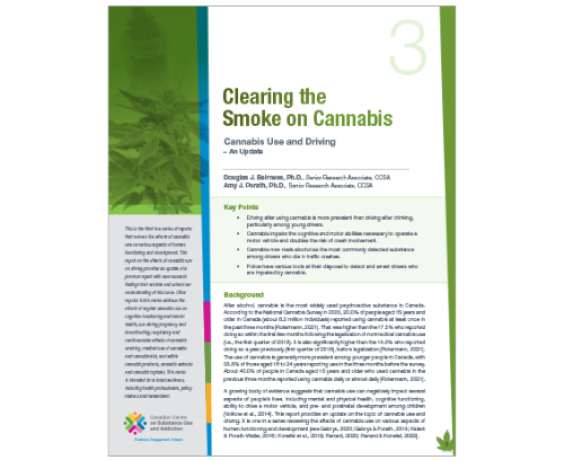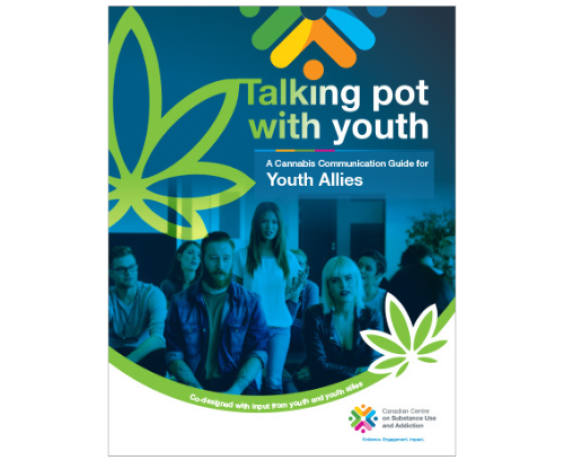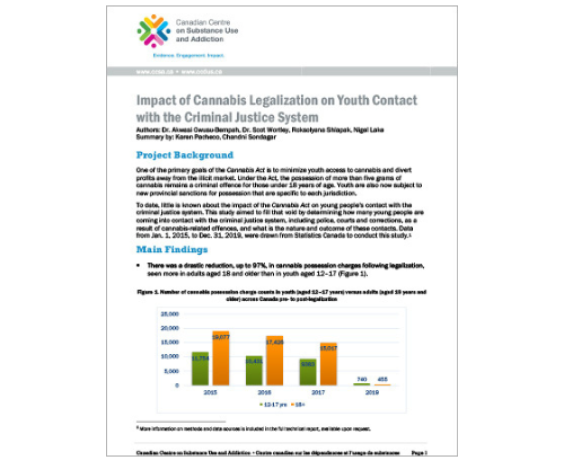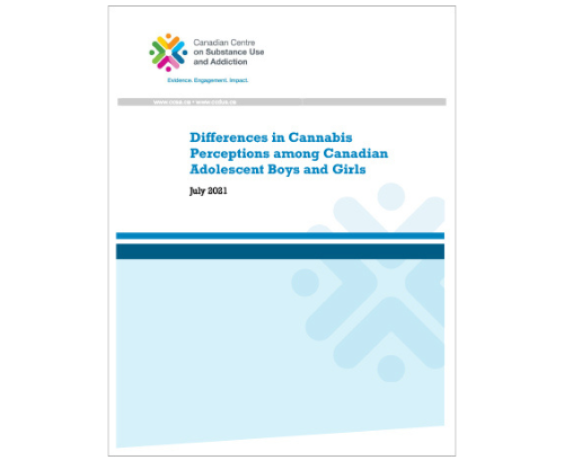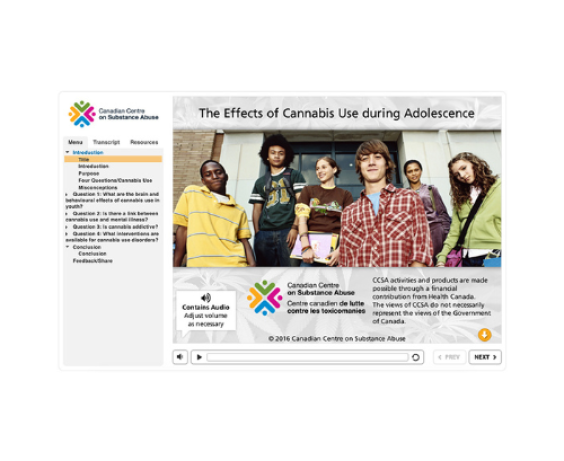Health Impacts of Cannabis
While the evidence on the medical applications of cannabis is limited, there are risks associated with regular cannabis use. Ongoing research is improving what we know about both risks and benefits.
Cannabis Use and Admittance to Inpatient Psychiatric Care
We know that there are complex interactions between cannabis use and mental illness, including an established relationship between regular cannabis use and psychosis. New research analyzes the correlation between cannabis use and admission to inpatient psychiatric care.
The report in short and infographic, Trends in Cannabis Use Prior to First Admission to Inpatient Psychiatry in Ontario, Canada, Between 2007 and 2017, are based on research that analyzed trends in nonmedical cannabis use in the 30 days before individuals were first admitted to inpatient psychiatric beds.
Key points include:
- Prior cannabis use has become more common among individuals at first admission to inpatient psychiatric beds in Ontario.
- Young adults (ages 18 to 24 years) were more likely to use cannabis before their first admission to inpatient psychiatry than older adults (ages 55 years and older).
- Cannabis use increased more in males than females between 2007 and 2017. Males with schizophrenia were more likely to use cannabis but females with schizophrenia were less likely to use cannabis.
- Having a mood disorder or experiencing mania or psychotic symptoms were strongly associated with cannabis use.
- Using tobacco and alcohol were strongly associated with cannabis use.
Psychotic Disorder and Cannabis Use
Between 2006 and 2015, the rate of hospitalizations related to cannabis use and mental and behavioural disorders more than doubled. In the same period, the rate of hospitalizations specific to cannabis-related psychotic disorders tripled. These findings are presented in the summary report, Psychotic Disorder and Cannabis Use: Canadian Hospitalization Trends, 2006– 2015.
Additional key findings include:
- Two-thirds of those hospitalized were male and approximately half were aged 15–24.
- Hospitalizations for psychotic disorder related to cannabis use accounted for one-third of mental or behavioural disorders between 2006–2015, increasing more than 25 per cent during this time.
- Education about the risks associated with cannabis use and ways to reduce those risks, such as following the lower-risk cannabis use guidelines, is important.
Please see the infographic as an additional resource to the report.
COVID-19 and Cannabis Smoking and Vaping
Since the beginning of the COVID-19 pandemic, there has been growing interest in the potential health benefits and medical application of cannabis to prevent and treat COVID-19 symptoms. There is no scientific evidence that demonstrates the benefits of either THC or CBD in preventing or treating COVID-19. Inhaling cannabis smoke can harm the lungs, which might increase susceptibility to COVID- 19 and worsen the symptoms of the disease.
The brief also includes four tips to reduce health risks for those who smoke cannabis.
- Cannabis smoke contains chemicals (toxins, carcinogens and irritants) that are known to negatively affect lung health.
- Smoking cannabis regularly can cause coughing, wheezing and tightness in the chest. Long- term cannabis smoking can also worsen chronic bronchitis.
- Smoking cannabis may suppress the immune system, which can make you more prone to infection from viruses.
- Vaping unregulated cannabis has been linked with severe lung illnesses.
This evidence summary outlines eight important facts people should know about COVID-19 and cannabis smoking or vaping.
Clearing the Smoke on Cannabis Series
The Clearing the Smoke on Cannabis series looks at how cannabis use affects mental and physical health, and discusses implications for policy and practice. Prepared and peer-reviewed by expert researchers in the field, this series addresses what we know about the health effects of cannabis use, what we don’t know and what needs further investigation.
Highlights
This report provides a summary of the seven publications in the Clearing the Smoke on Cannabis series.
- Regular cannabis use can increase the risk of developing psychosis and schizophrenia, especially among people with a family history of these illnesses.
- Using cannabis regularly prior to the age of 16 can lead to cognitive difficulties.
- Smoking cannabis regularly can lead to coughing, wheezing, sore throat, chest tightness at night, sounds in their chest, early morning phlegm and mucus, and bronchitis.
- There is limited evidence for a link between cannabis smoking and heart attack. Further studies are required to clarify whether heavy cannabis smoking is a risk factor for the onset of these complications.
- Using cannabis during pregnancy and breastfeeding can affect the development of the baby.
- Cannabis impairs the cognitive and motor abilities necessary to operate a motor vehicle and doubles the risk of being involved in a collision.
- Regular use of cannabis extracts or concentrates high in tetrahydrocannabinol (THC) is associated with tolerance, withdrawal and cannabis use disorder.
Respiratory and Cardiovascular Effects of Cannabis Smoking
The common belief that smoke inhaled from smoking cannabis is safe because cannabis is a natural plant is mistaken. Cannabis smoke contains many of the same chemicals (toxins, irritants and carcinogens) as tobacco smoke.
The latest report in the Clearing the Smoke on Cannabis series, Respiratory and Cardiovascular Effects of Cannabis Smoking highlights the risks to your heart and lungs from inhaling cannabis smoke. Report highlights include:
- Cannabis, when inhaled, can potentially trigger stroke, heart attack or inflammation of arteries, especially in those who use cannabis heavily.
- Cannabis smoking increases the risk for coughing, wheezing, aggravation of asthma, sore throat, tightness of chest and hoarse voice.
- It is not yet clear if there is a link between cannabis smoking and serious lung conditions such as lung cancer or chronic obstructive pulmonary disease (COPD).
- There is some evidence to suggest that quitting cannabis smoking can reverse some of the negative respiratory symptoms associated with smoking.
In addition to the report, CCSA has developed two public education resources to help Canadians understand and reduce the health risks associated with smoking cannabis:
Edible Cannabis Products, Cannabis Extracts and Cannabis Topicals
A completely new line of cannabis products is now available for purchase in Canada. Edible cannabis products, cannabis extracts and cannabis topicals have unique health and safety risks that are different from the risks associated with dried cannabis.
With these products, it is important to know that:
- Edible cannabis products can increase the risk of over-consumption and subsequent cannabis poisoning.
- As edible cannabis products look like “normal” food and beverages, there is an increase in the risk of unintentional ingestion, especially by children.
- High-potency cannabis extracts increase the risk of cannabis poisoning, even more so than dried cannabis.
- Regular use of these products has been associated with problematic cannabis use, cannabis use disorder and mental health disorders.
- Research on cannabis topicals, including the use of CBD products you apply to the skin, is very limited. However, there is a growing interest among dermatologists and consumers in these products.
- Health impacts associated with long-term use of edible cannabis products, cannabis extracts and cannabis topicals is unknown.
Medical Use of Cannabis and Cannabinoids
About 13 per cent of people living in Canada report using cannabis for medical purposes. This includes people with authorization from a healthcare provider and those who may be self-medicating.
There is growing evidence that the use of cannabis, cannabis-based products and medications (with THC, CBD or both) may be helpful in managing symptoms associated with certain health conditions, such as:
- Chemotherapy-induced nausea and vomiting
- Symptoms of multiple sclerosis
- Neuropathic pain
- Symptoms of some seizure disorders
Many people report that cannabis helps with a wide variety of health conditions, such as sleep, pain and anxiety. However, the available clinical evidence does not support many of the self-reported benefits or the use of cannabis to treat most health conditions, especially as a first-line treatment option.
Based on existing research and because of the associated risks of harms, cannabis use should only be considered for people who do not respond to first- and second-line treatments. People should speak with their healthcare provider before using cannabis for medical purposes.
Of the people in Canada who report using cannabis for medical purposes, most (74 per cent) do not have an authorization document from a healthcare professional and may be self-medicating. People without healthcare authorization who may be getting cannabis from the regulated or illegal market do not have safeguards in place to protect their health and safety.
These safeguards include guidance from a healthcare professional on dosing, potential medication interactions and adverse effects, how to reduce the risk of associated harms, and other available treatment options.
Vaping Linked to Serious Lung Disease
This report summarizes what is known about the recent emergence of severe lung injury associated with vaping, including probable causes and next steps for research. It incorporates the most current evidence and information available about the link between vaping and severe lung and pulmonary illnesses as of October 31, 2019.
Key findings from the report:
- Within 90 days of developing symptoms, all reported cases of lung injury have used an e-cigarette containing either THC, the psychoactive component of the cannabis plant that produces the “high,” nicotine or a combination of both.
- Most of the cases of emerging lung and respiratory disorders have been linked to vaping products containing THC from cannabis extracts.
- In most cases, the THC vape cartridges were not purchased from a regulated source, but rather from the illicit cannabis market.
- The U.S. Centers for Disease Control and the Food and Drug Administration are investigating potential toxicants in e-liquids such as vitamin E acetate, flavouring substances and solvents. Vitamin E acetate, often used to thicken cannabinoid-infused oils sold in the illicit market, has been identified as a chemical of concern among patients with severe lung injury.
- The short- and long-term health effects of vaping and vaping products are unknown and more studies are required to determine their health impacts.
- People should not use vaping products or e-cigarettes that contain THC, particularly those coming from the illicit cannabis market.
Regular Cannabis Use and Cognitive Functioning
Starting to smoke cannabis earlier in life — before 16 or 17 — is one of the strongest predictors of noticeable cognitive difficulties. However, the impact of regular cannabis use on cognitive functions is generally mild for most people. Many of the measurable effects on these functions disappear after sustained periods of not using cannabis.
- Regular cannabis use is associated with changes in brain structure and function, including changes to the brain’s natural reward pathways.
- Individuals who display risky and impulsive decision making are more likely to develop problematic cannabis use and cannabis use disorder.
- Establishing a standardized measurement of cannabis use, including frequency of use, dosage and methods of consumption, is required to explore the causal nature of these relationships.
Regular Cannabis Use and Mental Health
People who use cannabis regularly — one or more times per week over a period of months or years — could be at greater risk of developing psychosis or schizophrenia. This finding was determined through a review of the current body of research about the relationship between cannabis and a number of mental health conditions.
Additional findings of the report include:
- People with mental health conditions are more than twice as likely to use cannabis regularly.
- Regular cannabis use is generally associated with more harmful rather than beneficial effects among people with mental health conditions.
- A standardized measurement of cannabis use and larger studies are needed to understand better the relationship between cannabis and mental health.
Cannabis Use during Pregnancy
An estimated 16.9% of individuals of childbearing age (15–44 years) reported past-year use of cannabis in 2015 and 2% to 5% of pregnant individuals reported using cannabis during pregnancy. There is little evidence to suggest an association between cannabis use during pregnancy and increased risk of premature birth, miscarriage or major physical abnormalities. However, frequent cannabis use during pregnancy is associated with:
- Low birth weight and is part of a cluster of risk-factors correlated with other adverse birth outcomes;
- Altered neurodevelopment and cognition, and academic under-achievement; and
- Behavioural disturbances among children and young adults, including attention deficits, increased hyperactivity and impulsivity, and increased likelihood of delinquency and substance use.
New Cannabis Products
On October 17, 2019, the federal government made it legal to purchase and consume edible cannabis products, cannabis extracts and cannabis topicals.
What are these products? In the simplest terms, they are defined as follows:
These new cannabis products carry with them unique health and safety risks that are not associated with consuming dried cannabis. It is important to be aware and informed of these risks before choosing to use edible cannabis products, cannabis extracts or cannabis topicals in order to minimize adverse health outcomes.
In the months leading up to legalization, CCSA released a series of public education resources about the new cannabis products. The resources include information about the associated health and safety risks, how to lower the risks or adverse health outcomes, the differences between ingesting and inhaling cannabis products, and how to safely store your cannabis products.
Edible Cannabis Products, Cannabis Extracts and Cannabis Topicals: What You Need to Know
Each of these types of cannabis product has its own attributes and uses.
Edible cannabis can come in a range of products that are meant to be consumed by eating or drinking. Although some edible cannabis products might look like normal food items, they are not. These products provide no nutritional value.
Cannabis extracts can be in solid form (hash or hashish) or in liquid form (oil intended for vaping). These products can be vaped, smoked or ingested. Cannabis extracts can vary widely in their THC and CBD concentrations. Some extracts, such as cannabis oil distillates and shatter, can have up to 99% THC, whereas others can be mostly CBD with little THC. High-strength extracts can increase the risk of over-intoxication, especially among those who are new to cannabis.
Cannabis topicals are for application directly to the skin, hair or nails. The risk of intoxication and impairment following the application of cannabis topicals is believed to be low, although there has yet to be thorough research evaluating these potential effects.
Our primer provides a brief overview of each of these different type of cannabis products and their associated properties.
Inhaling vs Ingesting: What Is the Difference?
Inhaling and ingesting are the two most popular ways to consume cannabis. People need to know how each method can affect their health.
The way we consume cannabis determines how it enters the body. One method passes through the lungs and the other through the stomach. The differences between inhaling and ingesting have a great impact on:
Edible Cannabis: Tips for Lowering Your Risk
Consuming edible cannabis is an alternative method to smoking cannabis. When edible cannabis becomes legal this fall, many Canadians might be interested in trying the variety of options that become available. Before they do so, they need to be aware of the risks.
Eating or drinking cannabis affects the body differently than smoking or vaping it. People who choose to use edible cannabis products must educate themselves on how to do so in a lower-risk manner.
7 Things You Need To Know about Edible Cannabis provides guidance on what these products are and how to lower your risk. The topics covered include:
Cannabis Extracts: What You Should Know
Cannabis extracts are products containing cannabinoids extracted from the cannabis plant. THC (tetrahydrocannabinol) and CBD (cannabidiol) are the most common cannabinoids, but they have different effects. THC makes people intoxicated or high, while CBD is non-intoxicating and might provide therapeutic benefits.
Cannabis extracts vary widely in their THC and CBD concentrations. Some extracts can contain up to 99% THC, whereas others can contain mostly CBD with little THC.
Extracts can be solid (hash or hashish) or liquid (oil intended for vaping). Certain types are named after their appearance or texture including shatter, wax, honeycomb and budder.
You can consume cannabis extracts through:
7 Things You Need to Know about Cannabis Extracts provides information you should know about cannabis extracts and how to lower your risk when using them. The topics covered include:
Always Read the Label Before Consuming Edible Cannabis
Edible cannabis comes in a wide range of products including cookies, chocolates and beverages. The amount of THC in edible cannabis products can vary. However, in Canada, packages containing edible cannabis products are legally limited to a maximum of 10 mg of THC.
To reduce your risk of over-consumption, read the label before consuming an edible cannabis product. People who are new to cannabis should start low — no more than 2.5 mg of THC — and go slow!
This infographic highlights what people should know before they consume an edible cannabis product, including:
Cannabis Use and Driving
Cannabis impairs the cognitive and motor abilities necessary to safely operate a motor vehicle and doubles the risk of crash involvement.
For more information about cannabis and impaired driving, please see Drug-Impaired Driving and Driving Under the Influence of Cannabis.
Youth and Cannabis
With the legalization of cannabis, youth are seeking credible information from individuals they know and trust on the benefits and harms of cannabis use. They want to know the whole story. Young people are ready to have the conversation, but many who interact with them are not well prepared for it.
CCSA developed a communication guide to help educate youth allies on how to have safe, unbiased and non-judgmental conversations with young people about cannabis. By taking a harm reduction approach and providing a basis for communicating accurate information about cannabis, youth allies will be able to better support young people in making informed decisions about their cannabis use.
Since launch, the guide has had successful uptake from youth allies, many of whom indicated the guide effectively facilitated their conversation with youth about cannabis. More information about uptake and usage can be found in CCSA’s Cannabis Communication Guide Impact Story.
Youth, Cannabis and the Criminal Justice System
One of the primary objectives of the Cannabis Act is to protect youth and divert profits away from organized crime and illicit markets.
Through a targeted initiative, the Canadian Centre on Substance Use and Addiction (CCSA) provided funding to Dr. Akwasi Owusu-Bempah and Dr. Scot Wortley to research youth interactions with the criminal justice system, including the nature and outcomes of those interactions.
CCSA has released Impact of Cannabis Legalization on Youth Contact with the Criminal Justice System, a report summarizing key findings from the study.
Cannabis Use during Adolescence
The Effects of Cannabis Use during Adolescence, a report in the Substance Use in Canada series, reviews the evidence on what we do and do not know about how cannabis affects adolescents. The report addresses several important questions and key issues, including:
- What are the brain and behavioural effects of cannabis use in youth?
- Is there a link between cannabis and mental health?
- Is cannabis addictive?
- What interventions are available for cannabis use disorders?
The report concludes with A Call to Action. It gives parents, teachers, healthcare providers and policy makers the opportunity to develop and employ more effective youth drug use prevention and intervention programs.
